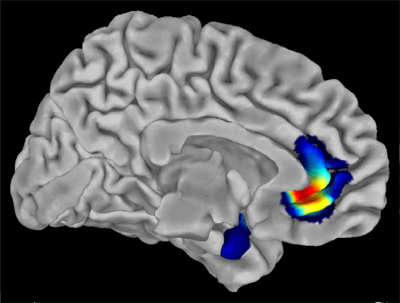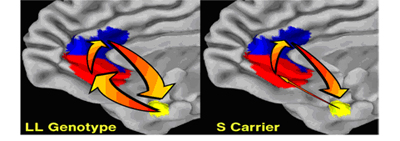
|
MRI Study Provides Insight in to DepressionNew Ideas on How Some People Interpret the World Around ThemThe NIMH research team first scanned 114 healthy subjects using magnetic resonance imaging (MRI). Those with at least one copy of the short variant had less gray matter (neurons and their connections) in the amygdala-cingulate circuit than those with two copies of the long variant. Next, using functional magnetic resonance imaging (fMRI), the researchers monitored the brain activity of 94 healthy participants while they were looking at scary faces, which activates fear circuitry. Those with the short variant showed less functional connectivity, in the same circuit. Nearly 30 percent of subjects� scores on a standard scale of �harm avoidance,� an inherited temperament trait associated with depression and anxiety, was explained by how well the mood-regulating circuit was connected. �Until now, it�s been hard to relate amygdala activity to temperament and genetic risk for depression,� said Dr. Andreas Meyer-Lindenberg, a lead author with Dr. Lukas Pezawas. �This study suggests that the cingulate�s ability to put the brakes on a runaway amygdala fear response depends upon the degree of connectivity in this circuit, which is influenced by the serotonin transporter gene.� Since serotonin activity plays a key role in wiring the brain�s emotion processing circuitry during early development, the researchers propose that the short variant leads to stunted coupling in the circuit, a poorly regulated amygdala response, and impaired emotional reactivity � resulting in increased vulnerability to persistent bad moods and eventually depression as life�s stresses take their toll. Other members of the NIMH team were: Dr. Bhaskar Kolachana, Dr. Michael Egan, Dr. Venakata Mattay, Emily Drabant, Beth Verchinski, and Karen Munoz. Dr. Ahmad Hariri, University of Pittsburgh, also participated in the study. 
Areas in the cingulate (right) and amygdala (left) that differed in gray matter volume between subjects with the short and long versions of the serotonin transporter gene. Short version carriers showed the greatest reductions in the red area, which previous studies have linked to depression. 
Subjects with two copies of the long version (LL) of the serotonin transporter gene showed more functional connectivity between the amygdala (yellow) and the cingulate (red, blue), which are key components of a mood-regulating circuit. Previous: Depression Gene May Weaken Mood-Regulating Circuit Adapted from: Depression Gene May Weaken Mood-Regulating Circuit
|
|
||||||||||||||||||
|


